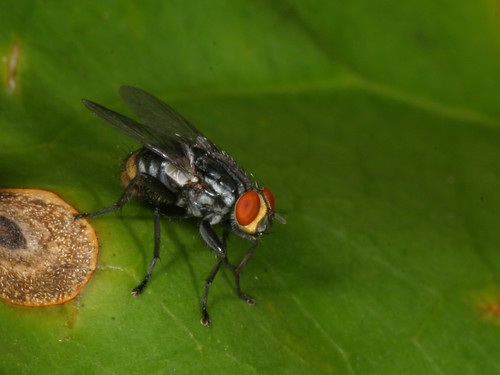Sunday, March 14, 2010
Sunday Spinelessness - Extreme Close-up
Almost all the photos I've used to illustrate these Sunday Spinelessness posts have been taken with my fixed lens digital camera. I think it does a pretty nice job in macro mode but sometimes you just want to get a little closer to your subject. I photographed each of the landsnails I collected for my PhD research so that I could have a record of their pigmentation, which degrades once you preserve a specimen in ethanol. Obviously, the more detail I could get the better so I borrowed some very exciting toys from the department's photography office:
The camera is a DSLR with a 100mm f2.8 macro lens, an extension tube and a twin flash. The mammal crashing this invertebrate-celebrating series is me.
Of course, I couldn't have a toy like this to play with and limit myself entirely to photographing snails. In amongst those important snail photos I have jumping spiders, hornets, geckos and really anything else that chanced across the porch I was taking photos on. One of the more striking subjects is this red-eyed fly:
And the head-on shot...
It turns out the pretty red-eyed fly is Oxysarcodexia taitensis, one of the Sarcophagidae. That family name gives you a clue to how this fly makes its living, it translates as "flesh eating" (it stems from the same root words as sarcophagus, the Greeks believed limestone ate away at corpses sealed in it). Most of the flesh-flies feed on dead animals but a few have earned a place in vertebrate nightmares, horror movies and even medical practice by depositing their maggots in on open wounds.
Relying on dead animals for food is a chancy business. Corpses are usually patchily distributed and there a plenty of other scavangers out there to compete with. This problem is especially bad for the larval stages of insects, without wings to get them to the next corpse their entire future depends on the continued existence of the flesh they are born on. The sarcophogids have developed a neat trick for making the most of corpse when they find one - they give birth to live maggots. Technically, the flesh flies are ovo-larviparous, meaning the larva develops inside an egg which is retained in the female until the larva hatches. Flesh-fly maggots can start eating as soon as they are born, maximizing their chances of getting through their lifecycle before another scavenger eats the corpse they live in.
It's easy to get freaked out about a creature that spends it's life eating decaying flesh but we should remember that flesh-flies play an important role in ecosystems. Sarcophigids and other scavengers turn dead flesh into living flesh. WD Hamilton, one of evolutionary biology's most insightful and original thinkers, recognised the important role of carrion feeding insects in his burial instructions:
"I will leave a sum in my last will for my body to be carried to Brazil and to these forests. It will be laid out in a manner secure against the possums and the vultures just as we make our chickens secure; and this great Coprophanaeus beetle will bury me. They will enter, will bury, will live on my flesh; and in the shape of their children and mine, I will escape death. No worm for me nor sordid fly, I will buzz in the dusk like a huge bumble bee. I will be many, buzz even as a swarm of motorbikes, be borne, body by flying body out into the Brazilian wilderness beneath the stars, lofted under those beautiful and un-fused elytra which we will all hold over our backs. So finally I too will shine like a violet ground beetle under a stone.".
Labels: Cook Islands, diptera, environment and ecology, flesh-fly, might interest someone, photos, Sarcophagidae, sci-blogs
3 Comments:
Amazingly beautiful photos, I am inspired.
You might like it even more now that I've fixed it (I originally copied and pasted it from the a mutated daughter-copy)
Sarah,
Well thanks, I'm not sure most people would be inspired by flesh eating flies but then, most people are boring. Now all you need is several thousand dollars worth of camera equipment to point and frogs and rotifers and drossies...







